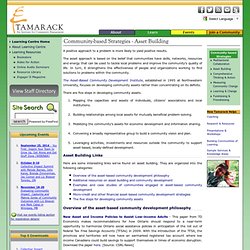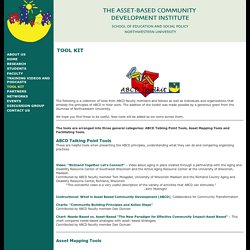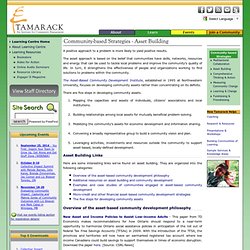

Programs. Programs CFED programs test and refine promising ideas in communities to find out what works.

All our programs depend on local partners, include a policy component and are designed to scale up if the program is deemed a success. The programs below are currently underway. Each tests an innovative strategy for expanding economic opportunity for low to moderate income Americans. 1:1 Fund Moving matched savings to the next level, the 1:1 Fund is an online community that connects students saving for college in qualified CSAs with donors who match their savings dollar for dollar. More Assets & Opportunity Network The national Assets & Opportunity Network is a movement-oriented group of advocates, practitioners, policymakers and others working to expand the reach and deepen the impact of asset-based strategies.
More Children's Savings Accounts Family ownership of even a few thousand dollars in assets can give children a transformative sense of possibility and hope for a brighter future. Communities Collaborating Institute Online. CFED. Your Learning Communities. Tamarack has three learning communities - each with their own site, learning events, and communities of practice.

They each center around a specific topic, though all three are complimentary to one another. Here is a little more about each of them: Tamarack CCI (Communities Collaborating for Impact) is a learning community for collaborative leaders utilizing a multi-sector approach to solve complex challenges. www.tamarackcci.ca. Tamarack Resource Library - Community-based Strategies - Asset Building. A positive approach to a problem is more likely to yield positive results.

The asset approach is based on the belief that communities have skills, networks, resources and energy that can be used to tackle local problems and improve the community’s quality of life. In turn, it strengthens the effectiveness of people and organizations working to find solutions to problems within the community. The Asset-Based Community Development Institute, established in 1995 at Northwestern University, focuses on developing community assets rather than concentrating on its deficits.
There are five steps in developing community assets. Mapping the capacities and assets of individuals, citizens’ associations and local institutions. Here are some interesting links we've found on asset building. Corporation for Enterprise Development (CFED) - CFED (Corporation for Enterprise Development) works with communities to help them envision, define and build their own economic strategies. Asset-Based Community Development Institute. The following is a collection of tools from ABCD faculty members and fellows as well as individuals and organizations that embody the principles of ABCD in their work.

The addition of the toolkit was made possible by a generous grant from the Alumnae of Northwestern University. We hope you find these to be useful. New tools will be added as we come across them. The tools are arranged into three general categories: ABCD Talking Point Tools, Asset Mapping Tools and Facilitating Tools. These are helpful tools when presenting the ABCD principles, understanding what they can do and comparing organizing practices. Video: “Richland Together Let’s Connect” – Video about aging in place created through a partnership with the Aging and Disability Resource Center of Southwest Wisconsin and the Active Aging Resource Center at the University of Wisconsin, Madison. “This wonderful video is a very useful description of the variety of activities that ABCD can stimulate.” –John McKnight. Resource Directory. Tamarack Learning Centre - Learn about Community Collaboration, Poverty Reduction, Leadership. Tamarack Resource Library - Community-based Strategies - Comprehensive Thinking and Action.
Complex local and social issues don’t lend themselves to “quick fix” solutions.

To make a strategic impact on the issues our communities face, we have to think and act in broader, more comprehensive ways. Comprehensive Community Initiatives (CCIs) are locally based efforts that work to improve community conditions and the lives of individuals and families by working comprehensively across social, economic and physical sectors. CCIs operate according to community building principles. They: Acknowledge the importance of strengthening capacity at the local level Enhance social capital and personal networks Develop leadership Encourage partnership and collaboration. In the Vibrant Communities initiative, communities and national organizations from across Canada are exploring how comprehensive community initiatives (CCIs) can be used as part of a deliberate strategy to reduce poverty in communities across Canada. Back to top. Additional Links. Tamarack Resource Library - Community-based Strategies - Asset Building.
A positive approach to a problem is more likely to yield positive results.

The asset approach is based on the belief that communities have skills, networks, resources and energy that can be used to tackle local problems and improve the community’s quality of life. In turn, it strengthens the effectiveness of people and organizations working to find solutions to problems within the community. The Asset-Based Community Development Institute, established in 1995 at Northwestern University, focuses on developing community assets rather than concentrating on its deficits. There are five steps in developing community assets. Mapping the capacities and assets of individuals, citizens’ associations and local institutions. Here are some interesting links we've found on asset building. Corporation for Enterprise Development (CFED) - CFED (Corporation for Enterprise Development) works with communities to help them envision, define and build their own economic strategies.